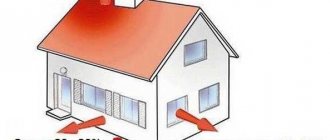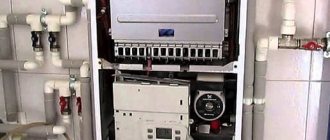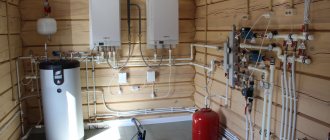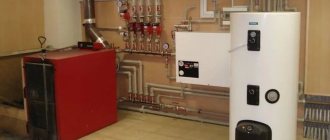A competent choice of boiler will allow you to maintain a comfortable indoor temperature during the winter season. A large selection of devices allows you to most accurately select the desired model depending on the required parameters. But in order to provide warmth in the house and at the same time avoid unnecessary expenditure of resources, you need to know how to calculate the power of a gas boiler for heating a private house.
A floor-standing gas boiler has greater power Source termoresurs.ru
Varieties of boiler models
Boilers can be divided into two types depending on the purpose of application:
- Single-circuit – used only for heating;
- Double-circuit – used for heating, as well as in hot water supply systems.
Units with one circuit have a simple structure, consisting of a burner and a single heat exchanger.
Single-circuit wall-mounted gas boiler Source ideahome.pp.ua
In dual-circuit systems, the water heating function is primarily provided. When using hot water, the heating is automatically turned off while hot water is being used so that the system is not overloaded. The advantage of a dual-circuit system is its compactness. Such a heating complex takes up much less space than if the hot water supply and heating systems were used separately.
Boiler models are often divided by placement method.
Depending on their type, boilers can be installed in different ways. You can choose a wall-mounted or floor-mounted model. It all depends on the preferences of the owner of the house, the capacity and functionality of the room in which the boiler will be located. The installation method of the boiler is also affected by its power. For example, floor-standing boilers have more power compared to wall-mounted models.
In addition to fundamental differences in purpose of use and placement methods, gas boilers also differ in control methods. There are models with electronic and mechanical control. Electronic systems can only operate in homes with constant access to the power grid.
Double-circuit gas boiler with indirect heating boiler Source norogum.am
See also: Catalog of companies that specialize in home insulation services.
Calculation by area
The easiest way to find out the required heat consumption is to calculate the power of the boiler room based on the area of the building. Over the years, experts have already calculated standard constants for some indoor heat transfer parameters. So, on average, to heat 10 square meters of area you need to spend 1 kW of thermal energy. These figures will be relevant for buildings built in compliance with heat loss technologies and a ceiling height of no more than 2.7 m. Now, based on the total area of the building, you can obtain the required boiler room power.
Typical device power calculations
There is no single algorithm for calculating both single- and double-circuit boilers - each system must be selected separately.
Formula for a typical project
When calculating the required power for heating a house built according to a standard design, that is, with a room height of no more than 3 meters, the volume of the premises is not taken into account, and the power indicator is calculated as follows:
- Determine the specific thermal power: Um = 1 kW/10 m2;
- Next, calculate the required power to heat the house.
Rm = Mind * P * Kr, where
P – a value equal to the sum of the areas of heated premises,
Kr is a correction factor that is taken in accordance with the climatic zone in which the building is located.
Some coefficient values for different regions of Russia:
- Southern – 0.9;
- Located in the middle zone – 1.2;
- Northern – 2.0.
- For the Moscow region, a coefficient value of 1.5 is taken.
This technique does not reflect the main factors influencing the microclimate in the house, and only approximately shows how to calculate the power of a gas boiler for a private home.
Some manufacturers issue recommendations, but for accurate calculations they still recommend contacting specialists Source parki48.ru
Example calculation for a single-circuit device installed in a room with an area of 100 m2, located in the Moscow region:
Рм = 1/10 * 100 * 1.5 = 15 (kW)
Calculations for dual-circuit devices
Double-circuit devices have the following operating principle. For heating, water is heated and supplied through the heating system to radiators, which release heat to the environment, thereby heating the rooms and cooling them. When cooling, the water flows back to be heated. Thus, water circulates along the heating system circuit, and goes through heating cycles and transfer to the radiators. At the moment when the ambient temperature becomes equal to the set one, the boiler goes into standby mode for some time, i.e. Temporarily stops heating the water, then starts heating again.
For domestic needs, the boiler heats water and supplies it to the taps, and not to the heating system.
Double-circuit heating system Source idn37.ru
When calculating the power of a device with two circuits, another 20% of the calculated value is usually added to the resulting power.
An example of calculation for a two-circuit device that is installed in a room with an area of 100 m2; the coefficient is taken for the Moscow region:
- Рм = 1/10 * 100 * 1.5 = 15 (kW)
- Ritogovaya = 15 + 15*20% = 18 (kW)
Determining the ideal ratio of power and economy
Several boilers included in one system
To follow the principles of economy, you need to take into account some more points when operating the boiler.
In cold weather, it is necessary to maintain a temperature in the house of 20-22 degrees; it is optimally comfortable for the human body. But given that the temperature changes during the winter, and the coldest days occur only a few times during the heating season, you can warm the house using a boiler with a power half lower than that obtained in the calculations.
For the normal functioning of the boiler for many years, it is better if it operates at rated rather than peak power. But during the heating season, the need to maintain a high temperature in the house sometimes disappears. To get out of this situation, mixing valves are used.
Mixing valve
They are needed so that you can regulate the temperature of the coolant in the batteries. For this purpose, hydraulic systems with thermohydraulic distributors or four-way valves are used. If they are installed in a heating system, the temperature can be changed with a regulator, leaving the boiler power constant.
After such upgrades, even a small boiler will operate in optimal mode, sufficient for high-quality heating of all rooms. This solution is quite expensive, but it will help save on fuel consumption.
- Another case is when the boiler has a power that is exceeded for a given room, and you don’t want to overpay for excess fuel, which should ensure its operation. To avoid these unpleasant expenses, you can install a buffer tank (battery tank), which is completely filled with water.
This addition will come in handy if solid fuel boilers are used for heating - the device will operate at full power, even if only short-term heat is required.
When the temperature outside rises and it is too early to turn off the boiler, the automatic valve begins to limit the flow of heated water into the radiators. He directs it to the heat exchanger of the buffer tank, and there it will heat the water that is already in the tank. The volume of the tank should be 10:1 in relation to the area of the house, for example, for 50 square meters of area you will need a tank with a volume of 500 liters.
Installing a storage tank provides significant energy savings
This water, having heated up, begins to function after the water in the circuit cools down - it begins to flow into the radiators, and the system will continue to heat the rooms for some time.
Additional factors taken into account when installing the boiler
In construction, there is also the concept of energy efficiency of a building, that is, how much heat a building releases to the environment.
One of the indicators of heat transfer is the dissipation coefficient (Kp). This value is a constant, i.e. constant and does not change when calculating the level of heat transfer of structures made of the same materials.
It is necessary to take into account not only the power of the boiler, but also the possible heat loss of the building itself Source pechiudachi.ru
For calculations, a coefficient is taken, which, depending on the building, can be equal to different values and the use of which will help you understand how to calculate the power of a gas boiler for a home more accurately:
- The lowest level of heat transfer, corresponding to a K value from 0.6 to 0.9, is assigned to buildings made of modern materials, with insulated floors, walls and roofs;
- Kr is equal to from 1.0 to 1.9, if the external walls of the building are insulated and the roof is insulated;
- Kr is equal to from 2.0 to 2.9 in houses without insulation, for example, brick houses with single masonry;
- Kr is equal to from 3.0 to 4.0 in non-insulated rooms, in which the level of thermal insulation is low.
The level of heat loss Qt is calculated in accordance with the formula:
Q t = V * P t * k / 860, where
V is the volume of the room,
Pt – temperature difference, calculated by subtracting the minimum possible air temperature in the region from the desired room temperature,
k – safety factor.
Modern gas boiler Source tr.decorexpro.com
The boiler power, when taking into account the dissipation coefficient, is calculated by multiplying the calculated level of heat loss by the safety factor (usually from 15% to 20%, then multiply by 1.15 and 1.20, respectively)
This technique allows you to more accurately determine productivity and, therefore, approach the issue of choosing a boiler as efficiently as possible.
What parameters, besides volume and area, influence the choice of boiler? And why is this important?
A simplified calculation formula often leads to the purchase of an unsuitable boiler. Each house is individual, and heat loss percentage cannot be equal for all houses. Before calculating power, consider the data of a specific house:
1) Measure the area of walls, windows, doors;
2) Specify the thickness of the walls, indicate the type of finishing and material, the height of the ceilings;
3) Observe the minimum temperature of the house in cold weather;
4) Determine the desired temperature as a result of installing the boiler;
5) Write down the thermal conductivity values for the materials from which the house was built.
| Wall material | Wall thickness and material thermal resistance | Required thickness for home |
| Brick (1600 kg/m³ - density) | 510 mm (if laying two bricks), R=0.73 °C m²/W | 1380 mm 2190 mm |
| Wooden beam | 150 mm, R=0.83 °С m²/W | 355 mm 565 mm |
| Expanded clay concrete (1200 kg/m³ - density.) | 300 mm, R=0.58 °С m²/W | 1025 mm 1630 mm |
| Wooden panel (inside filled with mineral wool + 25 mm layer of inner and outer cladding) | 150 mm, R=1.84 °С m²/W | 160 mm 235 mm |
| Arbolit | 0.80-0.17W/m² | — |
| Foam concrete | 0.14-0.38 W/m² | — |
| Aerated concrete | 0.18-0.28 W/m² | — |
Thermal resistance of materials
Why is this necessary? The key parameter influencing the choice of boiler is the heat loss of the house. Houses with the same area and volume, but different degrees of insulation, will require equipment of different power.
Where does the heat go:
| Surface | Heat loss in% |
| Roof and ventilation | 20-25% |
| Foundation, if it is adjacent to the ground | up to 15% |
| Walls, windows and doors | 10-15% |
| Ground floor and unheated rooms, basement, for example | up to 15% |
It also matters: how different the outside temperature is from the inside, the climatic region, the strength and direction of the wind, how the house stands relative to parts of the world.
| Heat loss |
What happens if you incorrectly calculate the required power
It is still worth choosing a boiler so that it matches the power required to heat the building. This will be the best option, since first of all, purchasing a boiler that does not match the power level can lead to two types of problems:
- A low-power boiler will always work at the limit, trying to heat the room to the set temperature, and can quickly fail;
- A device with an excessively high power level costs more and, even in economy mode, consumes more gas than a less powerful device.
Why count if you can buy a boiler with a power reserve?
Sometimes boilers have a capacity reserve. This is good when the reserve is no more than 25%. Especially when the family plans to develop the area: complete a swimming pool, sauna, or other heated area. When the required power is exceeded significantly, the owner spends extra money, and the equipment operates in abnormal mode:
| Boiler repair |
- Breaks or malfunctions;
- The efficiency of the system decreases;
- A higher power boiler costs more;
- More fuel is consumed than is required to heat the house;
- A more powerful and expensive pump will be needed;
- The house will be very hot;
- Automatic regulation becomes difficult, the boiler may boil;
- The boiler begins to cycle - it turns on and off in a short period of time, equipment components wear out;
- Condensation appears in the chimney. When burned, the condensate reacts with the emissions and produces acid. It destroys the chimney and sometimes the boiler.
Conclusion: frequent switching on and off wastes more fuel than continuous operation. Buying a boiler with excess power not only makes no sense, but is also harmful to the budget and equipment.
Calculator for calculating boiler power
For those who do not like to do calculations, even if they are not very complicated, a special calculator will help you calculate a boiler for heating your home - a free online application.
Interface of an online calculator for calculating boiler power Source idn37.ru
As a rule, the calculation service requires you to fill out all the fields, which will help you make the most accurate calculations, including the power of the device and the thermal insulation of the house.
To obtain the final result, you will also need to enter the total area that will require heating.
Next, you should fill out information about the type of glazing, the level of thermal insulation of walls, floors and ceilings. As additional parameters, the height at which the ceiling is located in the room is also taken into account, and information about the number of walls interacting with the street is entered. The number of floors of the building and the presence of structures on top of the house are taken into account.
After entering the required fields, the calculation button becomes “active” and you can get the calculation by clicking on the corresponding button. To check the information received, you can use calculation formulas.
Is it worth buying a boiler that is too powerful?
Modern heating equipment is equipped with automatic systems that allow you to regulate gas flow. This is very convenient because it eliminates unnecessary expenses. It may seem that an accurate calculation of the power of a heating boiler is not so important, because you can simply buy a boiler with high power ratings. But it's not that simple.
Correct selection of heating equipment will extend its service life
Unreasonably exceeding the thermal power of equipment can lead to:
- increasing costs for the acquisition of system elements;
- reducing the efficiency of the boiler;
- failures in the operation of automatic equipment;
- rapid wear of components;
- formation of condensation in the chimney, etc.
Thus, you need to try to “get into” exactly the power that suits your home.
Baxi gas boilers have proven themselves to be reliable heating equipment. Review of the model range with characteristics and features in our next material: .
Advantages of using gas boilers
Gas equipment has a number of advantages and disadvantages. The advantages include:
- possibility of partial automation of the boiler operation process;
- unlike other energy sources, natural gas has a low cost;
- The devices do not require frequent maintenance.
The disadvantages of gas systems include the high risk of gas explosion, however, with proper storage of gas cylinders and timely maintenance, this risk is minimal.
Is excess power needed?
You should not buy a model with a performance that significantly exceeds the maximum value (taking into account the 15-20% premium). Excess leads to negative consequences:
- High price. The more powerful the model, the more expensive it is. It is irrational to purchase equipment whose capabilities will not be used.
- Increased costs for consumables.
- Low burner efficiency - this will affect gas consumption.
- At minimal loads, the automation often fails.
- If the equipment is not optimal for a specific area, accelerated wear of components and parts occurs.
Performance reserve depending on the type of boiler
For a standard single-circuit boiler, regardless of the type of fuel used, we always recommend a power reserve of 15-25%, depending on the temperature in the coldest decade and the insulation of the house. However, in some cases a slightly larger margin is required:
- 20-30% reserve if the boiler is double-circuit. Most models operate on the principle of DHW priority, which means that at the moment the hot water consumption point is activated, the boiler does not heat the heating circuit; to operate on two circuits, higher performance is required;
- 20-25% of the reserve if supply and exhaust ventilation without heat recovery is organized or planned in the house.
A scheme with the connection of an indirect heating boiler is also often used (especially in conjunction with solid fuel boilers). In this case, excess capacity may exceed 40-50% (the figure is calculated according to the situation). It is worth understanding that in any of the cases, the provided reserve is not “idle”, but is used whether for the purpose of heating hot water, replenishing higher heat losses, or heating a buffer tank.
The tall white tank to the right of the boiler is an indirectly heated storage boiler that constantly maintains a large volume of hot water.
Heat loss accounting
When considering how much power is needed for a gas boiler, many consumers mistakenly believe that it depends only on the size of the house. In other words, it is enough to calculate this parameter by multiplying 1 kilowatt by 10 square meters. meters of area.
In reality, these calculations are not entirely correct, since they do not take into account heat loss. Heat can escape from doors, through cracks in window openings, walls and ceiling surfaces, so the main task of heating equipment is to compensate for the lack of lost heat and create a comfortable temperature.
The following factors influence heat losses:
- location of the building taking into account the climate of the area;
- total area of the heated room;
- location in relation to cardinal directions;
- type, size of double-glazed windows, doorways;
- thermal resistance of finishing materials;
- ventilation.
A complete calculation of heat loss requires the use of several dozen formulas, which is difficult for the average consumer. Therefore, when figuring out what power is needed for a gas boiler, it is enough to limit yourself to the maximum heat loss with a coefficient of 1.5.
This option usually has simple wooden windows without double-glazed windows, wooden doors without a vestibule and walls made of one brick or made of concrete. If the room is well insulated, equipped with double-glazed windows and double doors, it is advisable to use a coefficient of 1.15 for unaccounted losses.
What is room heat loss
Any room has certain heat losses. Heat comes out of walls, windows, floors, doors, ceilings, so the task of a gas boiler is to compensate for the amount of heat coming out and provide a certain temperature in the room. This requires a certain thermal power.
It has been experimentally established that the largest amount of heat escapes through the walls (up to 70%). Up to 30% of thermal energy can escape through the roof and windows, and up to 40% through the ventilation system. Lowest heat loss at doors (up to 6%) and floors (up to 15%)
The following factors influence heat loss at home.
- Location of the house. Each city has its own climatic characteristics. When calculating heat loss, it is necessary to take into account the critical negative temperature characteristic of the region, as well as the average temperature and duration of the heating season (for accurate calculations using the program).
- The location of the walls relative to the cardinal directions. It is known that the wind rose is located in the north side, so the heat loss of a wall located in this area will be the greatest. In winter, cold wind blows with great force from the western, northern and eastern sides, so the heat loss of these walls will be higher.
- The area of the heated room. The amount of heat lost depends on the size of the room, the area of walls, ceilings, windows, doors.
- Thermal engineering of building structures. Any material has its own coefficient of thermal resistance and heat transfer coefficient - the ability to pass a certain amount of heat through itself. To find them out, you need to use tabular data and also apply certain formulas. Information about the composition of walls, ceilings, floors, and their thickness can be found in the technical plan of housing.
- Window and door openings. Size, modification of door and double-glazed windows. The larger the area of window and door openings, the higher the heat loss. It is important to take into account the characteristics of installed doors and double-glazed windows when making calculations.
- Ventilation accounting. Ventilation always exists in the house, regardless of the presence of artificial hood. The room is ventilated through open windows; air movement is created when the entrance doors are closed and opened, people move from room to room, which helps warm air leave the room and circulate it.
Knowing the above parameters, you can not only calculate the heat losses of the house and determine the power of the boiler, but also identify places that need additional insulation.











